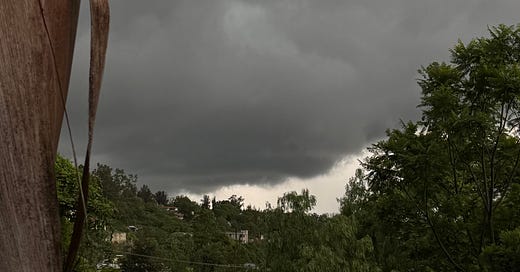“Ah, yes, it’s an intestinal infection,” said Dr. Elias as he gently prodded my belly. “They’re very common in this time of year, when the chance of being exposed to contaminated water is higher. Does this hurt?” I let out a low groan of confirmation from my horizontal perch on his examination table.
Many of my recent entries here have been about Oaxaca’s rainy season, la temporada de lluvia, and the dramatic changes it brings. Our house has been dive-bombed by nocturnal rhinoceros beetles, I went foraging for edible flying ants, and this past week, the coastline of Oaxaca was pummeled by Hurricane Erick, a category 3 storm that thankfully diminished in severity very shortly after making landfall. In addition to all of this, the landscape of Oaxaca’s interior, a typically dry and dusty environment blanketed by cacti, palm trees, and succulents, has been transformed. Every rocky slope and gnarled crevice has been filled with thriving plant life.
With the changing seasons, though, comes illness. The most serious is dengue fever, a mosquito-borne malady that causes such severe cramps and joint pain that it was originally called “break-bone fever,” and we’ve known several people who have been laid up for weeks with it. But more generally, Oaxacans put great stock in the idea that going from one extreme season to another without time to adjust, or even from one temperature to another, can cause gripa, an illness that sits somewhere between a cold and the flu.
Do I have the gripa? I asked myself one morning after waking up feeling exhausted, achy, and bloated. After all, the idea that cold and damp weather can bring on a cold is hardly foreign to an American. I barely had time to hold onto the thought before my intestines suddenly felt as if someone had filled them with hot lead, and pain began radiating from my midsection. I ran to the bathroom as Andrea called after me with alarm, “Are you ok?”
Mexican medical care takes on a bad rap, but that reputation is much more deserved when talking about the public medical system. As with the United States and now the U.K., the public health system is underfunded, and healthcare workers face such demand that they work to the point of breaking. But private medical care, in our experience thus far, has been excellent. When, after several days of increasing bloating and distress, I finally decided to reach out to the town doctor, Dr. Elias, he responded within an hour to offer me a same-day appointment. “How about 2 o’clock?” he wrote in Spanish, and I gratefully accepted the appointment time.
Elias’ examination was brief but thorough. He was pleased to see my blood pressure was excellent and that I wasn’t running a fever, and my ears and throat both looked fine. But when he had me lie down on the paper-covered examination table and put his stethoscope to my abdomen, he abruptly laughed and looked at me. “There’s a lot moving around down there!”
“Oh, I know,” I muttered crankily. A few minutes later, he had dismissed me from his office, and having purchased a mild antibiotic and an intestinal anti-inflammatory from the pharmacy attached to his practice, I began the short walk back home.
“So what did Elias say?” Andrea asked me after I trudged wearily to her office. I explained to her how the doctor said that I had likely been exposed to some sort of contaminated water, and we began discussing the various ways I might have been exposed. Nothing immediately presented itself as a likely option. Even the organic lettuce we had purchased from a respected local farm had been washed before we built our most recent salad. We were stumped.
It’s a common misconception that foodborne illness—Montezuma’s Revenge, here in Mexico—comes from your body simply not having had time to adjust to the local bacteria. In reality, what will make a traveler sick will also make a local sick. Your guts can’t and won’t get used to having Giardia or E. coli swirling around. It’s one of the reasons that a good gauge for whether a street food vendor is safe to eat from is if they have a healthy supply of local customers. No one wants to eat from the guy who’s going to send them running to the bathroom.
After a few days, my symptoms improved to the point that I was once again safely able to travel around the Valles Centrales, eat at restaurants, and otherwise not spend my days indoors near my bed or the bathroom. But when my symptoms resurfaced this morning, I promptly asked Dr. Elias for another appointment, and a few hours later had been prescribed a second round of antibiotics and some chewable probiotics to help reinforce my gut flora.
I would have preferred to have the gripa. While the idea of a vaguely mysterious illness brought on by temperature changes feels perhaps a little woo-woo, at least with the gripa, you can have some assurance that your symptoms are transient, a ghost flitting through your immune system. The cold reality of bacteria setting up shop in the twists and turns of your abdomen leaves you with the paranoid knowledge that you’ve ingested something you shouldn’t have. But in the absence of being certain of the source of my illness, there’s nothing to do but continue to eat well, wash our lettuce thoroughly, and perhaps wash my insides a bit more regularly with mezcal. For the sterilizing effect, of course.






Oh, sounds terrible. Here's to drinking more mezcal!
Tequila/mezcal cures everything!